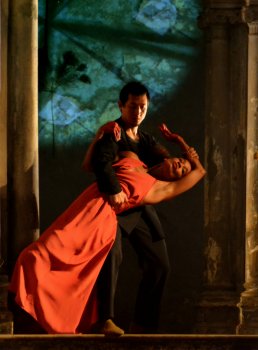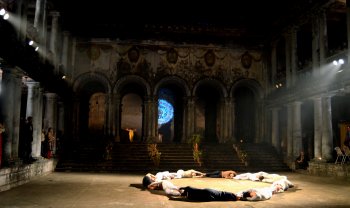 |
 |
Dialog 2013: A conversation between India and Germany - Sulagna Mukhopadhyay, Kolkata e-mail: sulagna64@gmail.com Pics: Shilbadhra Datta ©: Goethe –Institut / Max Mueller Bhavan Kolkata January 22, 2013 The colossal building with its relics, the thakurdalan (the place where gods and goddesses are worshipped), the andormahal (the place meant for women and also used for living) did not ever invoke any special feeling among the people living in that neighbourhood. It was just another ordinary building standing there, carrying the history of Bengal Renaissance and the Babu culture. Situated at a stone-throw distance from the Jorashanko Thakurbari (The Tagore House), Jorashanko Rajbati, a 250 year-old mansion belonging to the Roy family became a house of significance to all the city-dwellers of Kolkata mid-January. The Roys of today living in that campus are descendents of Raja Ramchandra Roy, a merchant. His father Sukhomoy Roy built this house and became the zamindar of that area during the time of the British. Photographs hanging on the walls of the building depict the glory days when they had an intense interaction with the officials of East India Company.  On the evening of 12 January 2013, guests and a few inquisitive passers-by slowly assembled in front of the main gate of the mansion to watch the house come alive through dance, music and shadow drama. With the clock striking half past six, the main entrance got illuminated with soft beige light and three dancers were seen on the parapet making minimal movements. There was no music and the dancers seemed like marble statues which could be found in such heritage buildings. As the door opened and the audience entered the sadar bari (the main building), a clock was seen hanging on the wall near the door, which raced back from real time to be a part of the era which Sasha Waltz projected in her production. Sasha Waltz is no new name in the dance history of the world. Based in Berlin, Sasha runs her company Sasha Waltz & Guests with her husband Jochen Sandig. Sasha took her first dance lessons with Waltraud Kornhass, a disciple of Marie Wiegmann. Later, she joined the School for New Dance Development in Amsterdam. She even visited America for training. In 1992, Waltz became the artist in residence in Kuenstlerhaus Bethanien. In 1993 she founded her company. Her career as a dancer kicked off over the following three years with her production Travelogue-Trilogy. Kolkata knows her since early nineties. Earlier she was here with her two productions. Both the productions were sponsored by Goethe Institut. This was her third visit to this city and her love for the architecture and history of the city brought her back to Kolkata. She visited the city last August with the aim of producing Dialog 2013. Her visit included quite a number of historical buildings, all situated on the dingy, narrow road of Chitpur in North Kolkata. Finally, she selected Jorashanko Rajbati, situated at the Ganesh Talkies crossing of Chitpur. She returned to Berlin and spoke to musicians of the Mahler Chamber Soloists and Padmini Chettur, a renowned contemporary dancer from Chennai and a disciple of dancer-choreographer Chandralekha. The production was supported this time by the Goethe Institut (Max Mueller Bhavan), Kolkata. With this event, Germany-India 2011-2012 Infinite Opportunities concluded. The site specific Dialog 2013 was staged on three consecutive days beginning 12 January 2013 and it would never be staged anywhere else in the world. In an interactive session held at Max Muller Bhavan shortly before the production, Sasha Waltz told Dr. Martin Waelde, the director of Max Mueller Bhavan, Kolkata, reputed dancer Vikram Iyenger and also her audience, that though the dancers had a basic structure to follow, they would have the liberty to improvise during the performance. The production included the historical time of British rule in India and the cultural scenario of Kolakta during that period, the history of the Roy family and also inhabitants living in that neighbourhood, poems, dialogues and vignettes, which at times sounded eccentric. The architecture became the protagonist for Sasha. Each room along with the courtyard and the thakurdalan became lively simultaneously and each place had a different thing to offer to its audience.  The central courtyard was dark when the audience was welcomed inside the house and dancers of Chettur were seen rolling through the rows of columns which encircled the courtyard. In the middle the dancers of Sasha silently formed rings by rolling on the floor and again dismantling them, showcasing the disorder and the order of the era. Across the courtyard was the place where once pujas were carried out. There were faded paintings of gods and goddesses. With the effect of light a chakra was created in the middle of that thakurdalan, and a little Radha was seen waiting for her Krishna. Draped in white pyjama-kurta, both Krishna and Radha take turn to appear there. The duration of each scene was not more than 5-10 minutes. So the audience did not have the chance to get bored. The staircase leading to the first floor of the mansion had pictures which showed the interaction between the then Governor of Bengal and the head of the Roy family. From one of the rooms, songs of Tagore could be heard. The audience assembled on the first floor and with fragmented beat of drums, the dancers suddenly started to gain momentum. Scenes began to change faster in the courtyard. There were exchanges at all levels - between the dancers of Sasha Waltz and Padmini Chettur, the audience and also the family members of the house. Men were seen sitting in the library, reading books or flipping through the pages of books covered with dust. The room once meant for round-table conference became alive with interaction between dancers and the audience present in that room. On the wall behind portraits of the family members were shown through projection. It was montage of the past and the present. In another room a man clad in dhoti danced alone while a solo violinist played the instrument. The baithankhana (the living room) gave a glimpse of the yesteryears through projection - the Hindu rituals, the family gathering and their interaction with the Brits. The Babu culture with its ecstasy wonderfully came alive in that living room. Though the room was inaccessible for any live performance, the shadow drama was enough to create an uncanny feeling among the audience. It seemed as if the ghosts had come alive and they were interacting with the visitors of that day. There was only one occasion when the dancers of Padmini Chettur over-ruled - the time when through mudras and vaachik they created an oriental dialogue, which the Indian audience was more acquainted with. The show ended with the dancers assembling on the thakurdalan, establishing a communication between the choreographies of the East and the West, between classical and contemporary dance forms. The costume designers Beate Borrmann and Margaretha were from Berlin but the costumes were stitched here in Kolkata. Some of the dancers from Germany wore simplistic versions of angrakhas and the pleated tops worn by the Gujarati people. The women’s costume included tights and the upper portion was a mixture of the evening gown and a kurta. The projection was conceived by Tapio Snellman, architect, urban-designer and film-maker. It was a unique experience. Light was conceptualised by Martin Hauk. Sulagna Mukhopadhyay was trained in Bharatanatyam by Guru Thankamani Kutty and Indian folk by Late Botu Pal. She has an M.A. in Comparative Literature and has freelanced for various leading newspapers of Kolkata like The Telegraph, The Statesman and Ananda Bazar Patrika. She has written articles on dance and gender issues. She is a teacher of South Point School since 1996. |